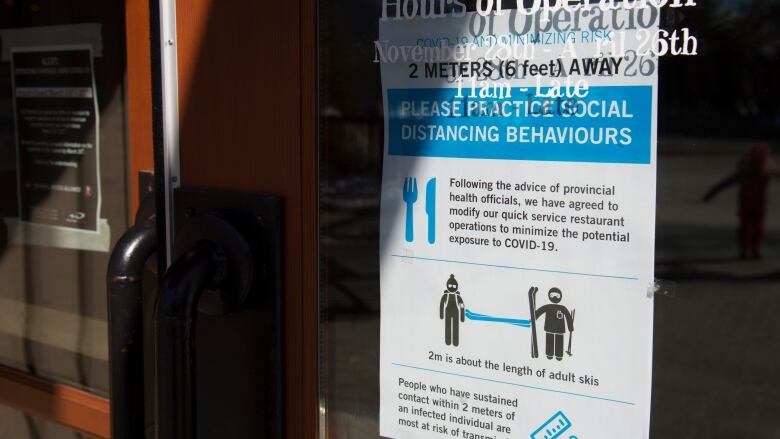Prepare to see COVID-19 cases rising. That doesn't mean social distancing has failed
Impacts won't be apparent for at least two weeks and probably longer, experts say

To get a glimpse of the coronavirus in Canada, it's necessary to watch this epidemic through a rear-view mirror.
TheCOVID-19 cases appearing today are a snapshot of infections that happened about two weeks ago.
It takes about fivedays for symptoms to appear and another sixor sevendays for people to become sick enough to seek medical help.
So the cases being counted now were infected in the first few days of March.
And because it takes about 16 days for an infected person to get critically ill, experts predict Canadians can expect to see severe cases ending up in Canada's intensive care units in the next few days.
"In the next two weeks, even though we've put these controls in place, we're going to see an increase in the number of confirmed cases and probably an increase in the number of severe cases," said Dr. David Buckeridge, a professor of epidemiology, biostatistics and public health at McGill University.
The pain of social distancing is going to feel futile in the first few weeks, he said.
"This is a tough place to be. We're going to feel the pain, and we're not going to see the benefits in terms of case count numbers."
"We're going to have this counterintuitive situation over the next couple of weeks where we're going to see confirmed cases and probably deaths rise even though we put into place these measures."
"But make no mistake, if we don't do this we're going to have a way larger increase in two to threeweeks. Instead of trying to bend the curve it's going to grow exponentially."
How many undetected cases?
The big question right now is the number of cases that are spreading undetected in the community.
"There's probably a pool of people who are truly infected out there that we don't know about that are driving the epidemic," said Buckeridge.
That's why Toronto epidemiologist Dr. David Fisman has been calling on Canadian politicians to implement stronger social distancing policies much sooner.
Fisman fears the window to flatten the curve of this epidemic might have been squandered.
"Our moment to slow this with social distancing has probably passed," he said via Twitter direct message. "It's pretty tragic."
"We have seen this repeatedly, and we know how it plays out."

Drastic social distancing measures put in place over the last few days are aimed at preventing a catastrophic surge on the health care system a situation that is already unfolding in Italy, Spain and France, countries that have health-care systems similar to Canada's.
Critical care physician Dr. Michael Warner drew the disturbing picture on Twitter using simple math. If 30 per centof Ontario's 14.5 million people become infected, about fiveper cent will need ICU care. That's about 217,000 patients. Warner pointed out that there are only about 400 ICU physicians in Ontario who normally care for 12 to 16 patients each per day.
"#SocialDistancing is difficult, but the math makes it mandatory," he tweeted on Sunday.
Simple #: 14.5m people in Ontario. 30% may contract #COVID19. ~ 5% will require ICU = 217,500 patients. There are ~ 400 ICU physicians in Ontario who normally care for 12-16 patients/MD/day. #SocialDistancing is difficult but the math makes it mandatoryhttps://t.co/EITIw7pitO
—@drmwarnerIt's estimated that every infected person passes the virus on to two people.The fewer social contacts each of us has, the fewer opportunities for the virus to jump from person to person.
At Memorial University in St. John's, mathematician AmyHurford created an interactive graph to demonstrate the effects of social distancing.
On her graph 0represents business as usual, with no social distancing. At the other end of the scale 100 represents complete isolation. The slider shows the effect on the epidemic curve at various degrees of social distancing.
"I think it gives you someidea of the difference you can make through social distancing," said Hurford.
Dr. Ross Upshur, a professor of clinical public health at the University of Toronto, has been getting calls from almost everyone he knows asking for information about this unprecedented situation and how long it will last.
"This is asking a lot of us," he said. "This is a very significant threat."
"We all know somebody who could be very badly affected."
How long? No 'happy answer'
"An outbreak is not over until you have two incubation periods without any new incident cases," said Upshur. Eachincubation period is14 days.
"So the big question is, how long do you keep up with the serious social distancing measures?"
How long? It's an uncomfortable question for anyone who has been watching this virus ravage the world.
"I don't have a happy answer to that one," said Buckeridge."My intuition is that we're going to be at this for a number of weeks if not a couple of months before we really get a handle on things."
"But I think in twoto three weeks we should hopefully see a differently shaped curve that we would have otherwise."
Buckeridge suggests Canadians watch the increasingly grim situation in other countries.
"It's news that is going to become far more dire coming out of Europe and the United States, which will hopefully allow us to strengthen our resolve."













_(720p).jpg)


 OFFICIAL HD MUSIC VIDEO.jpg)
.jpg)



























































































